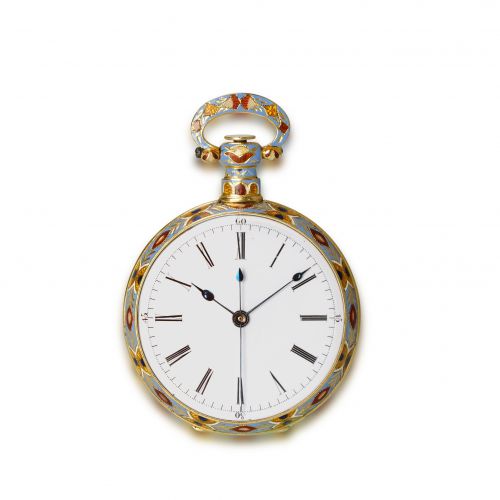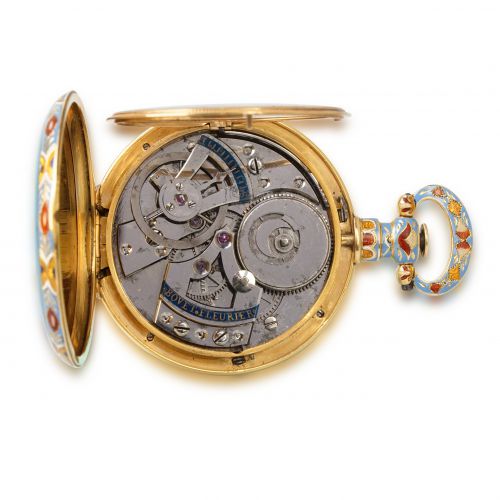Bovet Chinese Market Enamel Painting Pocket Watch
Inventory Number: PW2303005LC
Made in London, England, circa 1830, signed Bovet. 47mm, 18K yellow gold case with champlevé enamel bezels, pendant, and bow forming foliate and geometrical patterns. The enamel painting scene depicts flower bouquets on a blue background, specially made for the Chinese market. Case no. 346, white enamel dial with Roman numerals and blued steel hands. Mirror-polished steel Chinese caliber with duplex escapement.
Functions: hours, minutes and seconds.
On loan from the private collection of Mr. Yeung Sau Wong.
Brand History
Bovet Fleurier SA is a Swiss brand of luxury watchmaker registered in May 1, 1822 in London, U.K. by Édouard Bovet for the purposes of manufacturing watches exclusively for the Chinese market. It is most noted for its pocket watches manufactured for the Chinese market in the 19th century. In 1823(the 3rd year of DaoGuang Emperor), Bovet brothers established company in Canton, China, later due to the Opium War, they were forced to their family and business to Macau for a while. It was about this time that the company created a Chinese name to more effectively market to the middle class. The Chinese name for Bovet, "Bo Wei", became a common noun for watches in China for many years. Now they still produce high-end artistic watches.
Glossary of Material Terms
Enamel
A vitreous substance which main component is silica mixed with oxides (transition metals) that create a vast palette of colors. Enamel is used to decorate metal surfaces, gold, silver, and copper.
Painting on the Enamel
A gold or copper plate is coated with base enamel and then fired. The colors are in powder form which the enamel-painter dilutes as and when they are needed using an oily or semi-oily essence, before applying them with a fine brush. Each color is dried and then fired before the next is applied. A work can be fired numerous times.
The Chinese market pocket watch is the pocket watch that was specially made for the Chinese market in the 18th to 19th centuries by European watchmakers. It was originally used as a tribute to the Qing Dynasty royal family and spread among the public gradually. Many cases were generally made of silver, brass, gilt-brass, or silver, and decorated with painted enamel with pearls or precious jewels.
The movements are so-called “Chinese Caliber”, and many of them were engraved with beautiful patterns such as scrolled flowers and foliage, the designs were significantly recognizable. From the Chinese collectors ‘view, these kinds of pocket watches are called "The big-eight pieces”. (There is such a statement that the movement was usually designed to consist of a barrel and seven main components, eight pieces in total, and “eight" is considered as the homonym of "fortune" in Chinese, so they were gradually known as "The big-eight pieces" from the 19th century in Chinese.







